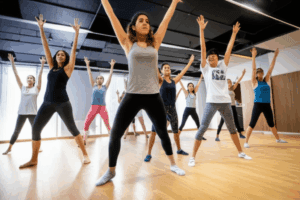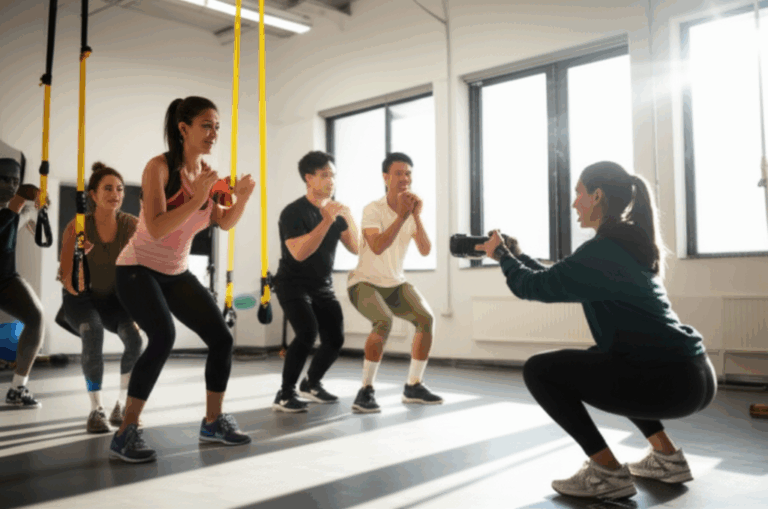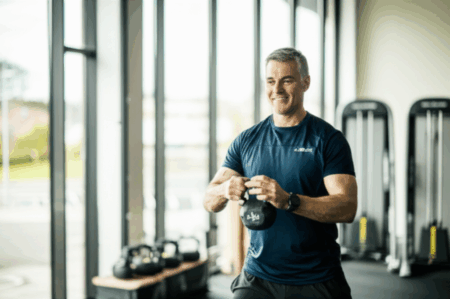Health and fitness are not just buzzwords; they’re integral components of a fulfilling life. In 2025, the landscape of health and fitness is rapidly evolving, driven by technological advancements, a deeper understanding of holistic well-being, and a growing emphasis on personalized approaches. Whether you’re a seasoned athlete or just beginning your wellness journey, understanding these trends can empower you to make informed decisions and achieve your health goals.
Top Health and Fitness Trends in 2025
Several key trends are set to dominate the health and fitness scene in 2025. Staying informed about these trends can help you optimize your wellness routine and achieve better results.
The Rise of Wearable Technology
Wearable technology continues to be a dominant force in the fitness world. From smartwatches to fitness trackers and biometric rings, these devices provide real-time data on various health metrics, including heart rate, sleep patterns, activity levels, and more.
- Benefits:
- Data-Driven Training: Wearables provide personalized insights that can help you tailor your workouts to your specific needs and goals.
- Motivation and Engagement: Tracking your progress can be highly motivating, encouraging you to stay consistent with your fitness routine.
- Early Detection: Some wearables can detect irregularities in heart rate or sleep patterns, prompting you to seek medical advice early on.
- Considerations:
- Data Privacy: Be mindful of the data you’re sharing and choose devices from reputable brands with strong privacy policies.
- Accuracy: While wearables can provide valuable insights, they’re not always 100% accurate. Use the data as a guide, but always listen to your body.
Mobile Exercise Apps
Mobile exercise apps are becoming increasingly sophisticated, offering a wide range of features, from guided workouts and personalized training plans to nutrition tracking and social support.
- Benefits:
- Convenience and Accessibility: Exercise apps allow you to work out anytime, anywhere, without the need for a gym membership.
- Variety: Many apps offer a diverse range of workouts, from HIIT and strength training to yoga and Pilates, catering to different interests and fitness levels.
- Personalized Training: Some apps use AI to create customized workout plans based on your fitness level, goals, and preferences.
AI-Enhanced Training
Artificial intelligence (AI) is revolutionizing the way we approach fitness, offering personalized insights and guidance that were previously only available through personal trainers.
- Benefits:
- Personalized Workout Plans: AI algorithms can analyze your fitness data and create customized workout plans that are tailored to your specific needs and goals.
- Real-Time Feedback: Some AI-powered fitness platforms provide real-time feedback on your form and technique, helping you avoid injuries and maximize your results.
- Motivation and Support: AI chatbots can provide motivation, answer your questions, and help you stay on track with your fitness goals.
- Considerations:
- Human Interaction: While AI can be a valuable tool, it’s important to remember that it can’t replace the expertise and support of a qualified human trainer.
- Data Accuracy: The accuracy of AI-powered fitness platforms depends on the quality of the data they’re trained on. Choose platforms that are based on sound scientific principles.
Hybrid Training
Hybrid training, which combines different types of workouts, is gaining popularity as people seek well-rounded fitness routines that target various aspects of their health.
- Examples:
- Combining strength training with cardio for a comprehensive workout.
- Alternating between high-intensity interval training (HIIT) and low-intensity steady-state (LISS) cardio.
- Incorporating yoga or Pilates into your routine for flexibility and mobility.
- Benefits:
- Improved Overall Fitness: Hybrid training can help you develop strength, endurance, flexibility, and balance.
- Reduced Risk of Injury: By diversifying your workouts, you can reduce your risk of overuse injuries.
- Increased Motivation: Mixing things up can keep your workouts interesting and prevent boredom.
Strength Training for Women
Strength training is no longer just for men. More and more women are discovering the numerous benefits of strength training, including increased muscle mass, improved bone density, and enhanced metabolism.
- Benefits:
- Increased Muscle Mass: Strength training helps build lean muscle mass, which can boost your metabolism and help you burn more calories even when you’re at rest.
- Improved Bone Density: Strength training can help prevent osteoporosis and reduce your risk of fractures.
- Enhanced Strength and Endurance: Strength training can make everyday activities easier and improve your overall physical performance.
- Tips for Women:
- Start Slowly: Begin with bodyweight exercises or light weights and gradually increase the intensity as you get stronger.
- Focus on Form: Proper form is essential to prevent injuries and maximize your results.
- Don’t Be Afraid to Lift Heavy: Lifting heavy weights can help you build muscle and strength, but it’s important to listen to your body and avoid pushing yourself too hard.
Exercise for Mental Health
The connection between physical activity and mental well-being is becoming increasingly clear. Exercise can help reduce stress, anxiety, and depression, while also improving mood, sleep quality, and cognitive function.
- Benefits:
- Reduced Stress and Anxiety: Exercise can help lower cortisol levels, which are associated with stress, and increase endorphins, which have mood-boosting effects.
- Improved Mood: Regular physical activity can help alleviate symptoms of depression and improve overall mood.
- Better Sleep: Exercise can help regulate your sleep-wake cycle and improve sleep quality.
- Enhanced Cognitive Function: Exercise can improve memory, attention, and processing speed.
- Types of Exercise:
- Aerobic Exercise: Activities like running, swimming, and cycling can be particularly effective for improving mood and reducing anxiety.
- Yoga and Tai Chi: These mind-body practices can help reduce stress and improve relaxation.
- Strength Training: Strength training can help boost self-esteem and improve overall mental well-being.
Functional Fitness
Functional fitness focuses on exercises that mimic real-life movements, helping you improve your strength, balance, and coordination for everyday activities.
- Examples:
- Squats: Mimic the motion of sitting down and standing up.
- Lunges: Improve balance and coordination while walking or climbing stairs.
- Push-ups: Strengthen your chest, shoulders, and triceps for pushing activities.
- Benefits:
- Improved Daily Function: Functional fitness exercises can make everyday tasks easier and reduce your risk of injuries.
- Enhanced Balance and Coordination: These exercises can improve your balance and coordination, reducing your risk of falls.
- Increased Strength and Endurance: Functional fitness exercises can help you build strength and endurance in the muscles you use most often.
Mindful Recovery
Recovery is no longer just a side note in fitness; it’s a core component of holistic health. Practices like restorative yoga, meditation, saunas, and massage therapy are gaining momentum for their ability to rejuvenate both the body and mind.
- Benefits:
- Injury Prevention: Prioritizing recovery can help prevent overuse injuries and burnout.
- Stress Reduction: Restorative practices can help lower cortisol levels and promote relaxation.
- Improved Performance: Adequate recovery can improve your athletic performance by allowing your muscles to repair and rebuild.
Social Fitness
Fitness is becoming increasingly social, with run clubs, group fitness classes, and online communities providing opportunities to connect with like-minded individuals and stay motivated.
- Benefits:
- Increased Motivation: Working out with others can help you stay motivated and accountable.
- Social Support: Group fitness can provide a sense of community and support, which can be particularly beneficial for those who are new to exercise.
- Fun and Enjoyment: Working out with friends can make exercise more fun and enjoyable.
Hormone Tracking
Hormone tracking is gaining traction, particularly among women, as a way to understand how hormonal fluctuations can impact energy levels, mood, and athletic performance.
- Benefits:
- Personalized Training: Tracking your hormones can help you tailor your workouts to your menstrual cycle, optimizing your performance and reducing your risk of injuries.
- Improved Understanding of Your Body: Understanding how your hormones affect your body can empower you to make informed decisions about your health and well-being.
- Considerations:
- Accuracy: Hormone tracking apps and devices are not always 100% accurate. Consult with a healthcare professional for accurate hormone testing and interpretation.
Nutrition for Optimal Health and Fitness
Nutrition plays a crucial role in achieving your health and fitness goals. A balanced diet that includes plenty of fruits, vegetables, whole grains, lean proteins, and healthy fats can provide the energy and nutrients you need to fuel your workouts, recover effectively, and maintain overall health.
Key Nutritional Guidelines
- Eat a Variety of Foods: Consume a wide range of foods from all the major food groups to ensure you’re getting a diverse array of nutrients.
- Prioritize Whole Foods: Choose fresh, unprocessed foods over packaged options whenever possible.
- Stay Hydrated: Drink plenty of water throughout the day to support digestion, metabolism, and overall well-being.
- Limit Added Sugars: Opt for naturally sweet foods like fruits instead of sugary snacks and beverages.
- Incorporate Healthy Fats: Add avocados, nuts, seeds, and olive oil to meals for heart-healthy fats.
Debunking Common Fitness Myths
It’s important to be aware of common fitness myths that can hinder your progress and lead to injuries. Here are a few to watch out for:
- Myth: Cardio is the best way to lose weight.
- Fact: While cardio can burn calories, strength training is also essential for building muscle and boosting your metabolism.
- Myth: Lifting weights will make you bulky.
- Fact: Lifting weights can help you build muscle, but it takes time and effort to develop a bulky physique.
- Myth: Stretching before exercise prevents injuries.
- Fact: Dynamic stretching is more effective for preparing your muscles for exercise. Static stretching is best done after your workout.
- Myth: No pain, no gain.
- Fact: Pushing yourself too hard can lead to injuries and burnout. It’s important to listen to your body and take rest days when needed.
Tips for Beginners
Starting a new health and fitness routine can be daunting, but it doesn’t have to be. Here are a few tips to help you get started:
- Consult with a Healthcare Professional: Before starting any new exercise program, it’s important to consult with your doctor to ensure you’re healthy enough to participate.
- Set Realistic Goals: Start with small, achievable goals and gradually increase the intensity and duration of your workouts as you get stronger.
- Find Activities You Enjoy: Choose activities that you find fun and engaging to increase your chances of sticking with your routine.
- Start Slowly: Begin with low-intensity exercises and gradually increase the intensity as your body adapts.
- Listen to Your Body: Pay attention to your body’s signals and take rest days when needed.
- Stay Hydrated: Drink plenty of water throughout the day to support your workouts and overall health.
- Be Patient: It takes time to see results, so be patient and persistent with your efforts.
The Future of Health and Fitness
The health and fitness industry is constantly evolving, driven by technological advancements, scientific discoveries, and changing consumer preferences. Some of the trends that are likely to shape the future of health and fitness include:
- Personalized Medicine: Advances in genetics and other fields are paving the way for personalized medicine, which will allow healthcare professionals to tailor treatments and interventions to individual patients based on their unique characteristics.
- Digital Health: Digital health technologies, such as telehealth, wearable sensors, and mobile apps, are transforming the way people access and manage their health.
- Virtual Reality (VR) and Augmented Reality (AR): VR and AR technologies are being used to create immersive and engaging fitness experiences, making exercise more fun and accessible.
- Focus on Prevention: There’s a growing emphasis on preventive care, with people taking proactive steps to maintain their health and well-being through healthy lifestyle choices.
Conclusion
Staying informed about the latest health and fitness trends is essential for optimizing your wellness journey. By embracing new technologies, incorporating diverse workouts, prioritizing recovery, and focusing on nutrition, you can achieve your health goals and live a more fulfilling life. Remember to consult with healthcare professionals and fitness experts to create a personalized plan that’s tailored to your specific needs and goals. Embrace the fitness forward movement and take charge of your health today.







